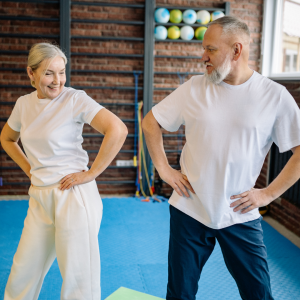Get Strong and Avoid Hip Osteoarthritis with a Hip and Core Strengthening Program
 As we age, it is crucial to maintain and strengthen an essential muscle group – the core. Core strength is fundamental for many activities as this muscle group stabilizes your body. It allows you to keep balanced and can impact how your arms and legs function. Strengthening the muscles of the core and hips is also pivotal in preventing the common condition of hip osteoarthritis.
As we age, it is crucial to maintain and strengthen an essential muscle group – the core. Core strength is fundamental for many activities as this muscle group stabilizes your body. It allows you to keep balanced and can impact how your arms and legs function. Strengthening the muscles of the core and hips is also pivotal in preventing the common condition of hip osteoarthritis.
Matt Pitton, PT, DPT, OCS, ACT, COMT, physical therapist for Orthoapedic Hospital of Wisconsin, describes hip osteoarthritis and lays out several exercises you can incorporate into your fitness routine to prevent and manage this common condition.
What is Hip Osteoarthritis?
Arthritis is a common condition that is more likely to develop as we age.  The symptoms include pain and swelling in the joints. Osteoarthritis is a type of arthritis that occurs when the inflammation of arthritis begins to break down the cartilage within the joints. Cartilage is the thick rubbery tissue that connects our joints and acts as a shock absorber. Cartilage is vital for smooth, balanced, and flexible movements.
The symptoms include pain and swelling in the joints. Osteoarthritis is a type of arthritis that occurs when the inflammation of arthritis begins to break down the cartilage within the joints. Cartilage is the thick rubbery tissue that connects our joints and acts as a shock absorber. Cartilage is vital for smooth, balanced, and flexible movements.
Hip osteoarthritis is one of the more common forms of osteoarthritis that occurs during the aging process. Over 32 million US adults are affected by osteoarthritis, and around 1 million hip and knee replacements are performed each year, often to address the symptoms of osteoarthritis.
Risk factors for osteoarthritis:
- Joint injury or overuse
- Age
- Gender
- Obesity
- Genetics
- Race
Osteoarthritis is diagnosable through a review of symptoms, physical examination, X-rays, and lab tests. Unfortunately, there is no cure for osteoarthritis because our body cannot regrow cartilage. Thankfully, treatment may be available, including activity modification, exercise, weight loss, medication, supportive devices, and surgery.
Prevent and Manage Hip Osteoarthritis
Maintaining strength and flexibility in your core and hip muscles can prevent and manage hip osteoarthritis. Additionally, Building these muscles will also help patients recover from a total hip replacement. Key muscles that play a part in stabilizing your core are the abdominals (rectus abdominus, transverse abdominus, internal obliques, and external obliques), erector spinae, multifidi, diaphragm, pelvic floor muscles, quadruatus lumborum, and gluteals. Many other hip muscles play a secondary role in stabilizing the pelvis in a standing or kneeling position.
Exercises for Hip and Core Strength
Stretches for Hip and Core Strength
Maintain control with each exercise and perform them slowly to engage the proper stabilizing muscles and prevent further injury by performing exercises incorrectly. A physical therapist can assess your strength and range of motion and prescribe the best specific movements that will work for you.
To begin working with one of our talented orthopedic physical therapists, make an appointment today.

